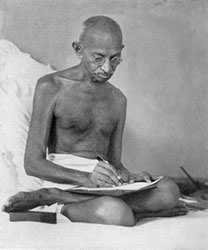
P.O. SEVAGRAM, DIST.WARDHA 442102, MS, INDIA. Phone: 91-7152-284753
FOUNDED BY MAHATMA GANDHI IN 1936
Short Stories For Everyone
Inspiring incidents from Gandhiji's Life: Selected from the book Everyone's Gandhi
(For the children in the age group of 10 to 15 years)

SHORT STORIES FOR EVERYONE
Gandhi's inspiring short stories selected from the book Everyone's Gandhi
Editor by : Rita Roy
Table of Contents
- All for A Stone
- A Car And A Pair of Binoculars
- My Master's Master
- Enter The Monkeys
- Premchand Quits His Job
- Returning His Medals
- Basic Pen
- Prisoner No. 1739
- Gandhi's White Brother
- Who Saw Gandhi?
- An Early School
- An Unusual March
- Spiritual Heir
- The Less You Have The More You Are
- An Old Goat Talks
- The Phoenix Settlement
- Gandhi in Amsterdam
- Something To Be Shy About?
- Gandhiji The Matchmaker
- Gandhi's Army
- Dandi Snippet
- Hiding Something
- The Image Maker
- Creative Reader
- Postcards To The Rescue
- A Non-violent Satyagraha 214 Years Ago
- Gandhi And Delhi
- Gandhiji's Constructive Programme
- Gandhi Looks At Leprosy
- Baba Amte
- They Gave Peace A Chance
- From Mahatma To God
- Customs Are Out of Fashion
- The Man 'Charlie' Wanted To Meet
- It Came Naturally To Him
- Crossing The Sea of Narrow-Mindedness
- Wear Clothes As They Should Be Worn
- Education: For Life, Through Life
- The Abode of Joy
- To Cling to A Belief
- The Fruit of A Child's Labour
- An Ideal Prisoner
- How A Film Became Something More
- Gandhi: Beyond India
- Gandhi's Life-Saving Medicine
- Understanding The Mechanics of Life With Gandhi
- The Lokmanya and The Mahatma
- Man's Gift To Nature
- Gurudev And His Mahatma
- One-man Boundary Force
- What Does Mahatma Gandhi's Message Mean To Me?
- Let's Play Together
- Children's Response To Conflict
- Beggar By Choice
- The Better Half
- Uncle Gandhi
- The Watch: An Instrument For Regulating Life
- Light The Lamp of Your Mind
- Gandhi's Bet!
- Gandhi Feeling At Home In The Kitchen
- What Is Simplicity?
- Bapu And The Sardar
- The Power of Quality
- Gandhi: The Teenager!
Chapter 53: Children's Response To Conflict
Chris King
Despite availability of co-operative games it becomes extremely difficult and almost impossible to avoid a violent solution of conflict. Is it possible to save ourselves from this unpleasantness?
In the USA there is a small movement aimed at helping children learn that they can solve their conflicts in creative rather than hurtful ways. This programme is called "Children's Creative Response to Conflict" (CCRC). Non-violent Alternatives, the organization I work with at Brookings, SD, uses this programme to teach adults, especially teachers and parents, how they teach children to resolve conflicts creatively.
It offers specially designed activities that enable children to build a sense of community, know their worth as individuals, and develop the skills of creative conflict resolution. Through these activities children and adults experience new ways to examine conflicts and develop solutions. They allow the participants to have fun while developing skills in one or more of the programmer's central themes.
Cooperation activities provide a structured setting that allows individuals to work together toward a common goal; an experience often lacking in our competitive society.
Honest communication about one's needs and feelings is often necessary in order to discover the heart of conflict. Activities that helps improve listening, observing, speaking and perceiving skills are important in preparing for successful conflict management.
If people do not feel positive about themselves, it is difficult to feel positive about others. Affirmation activities demonstrate that everyone's ideas and feelings are valued, thus opening the to creative conflict resolution. One of the main goals of this is to show many alternative solutions to conflict and therefore there is an attempt to produce situations in which participants find themselves, and thus practise creative conflict resolution.
Sessions begin by inviting everyone to sit in a circle to emphasize equality and encourage participation.
Gandhi understood that for power to be used in a mutually creative way it must be grounded in love, rather than in fear of punishment. Conflicts are usually resolved by the use of power. When resolved creatively, the power is grounded in love and shared in a mutually beneficial way; when resolved in hurtful and destructive ways, the power is often derived from fear of punishment and or threat of the use of force.